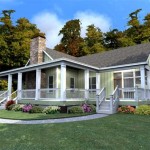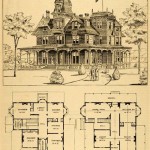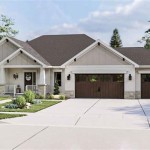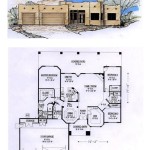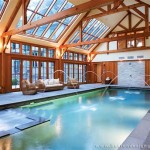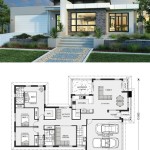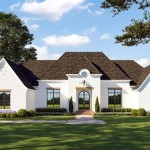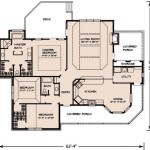Modern Mountain Home Floor Plans: Blending Aesthetics and Functionality
Modern mountain home floor plans represent a compelling fusion of contemporary design principles and the intrinsic beauty of natural landscapes. These plans prioritize open spaces, natural light, and seamless integration with the surrounding environment, creating dwellings that are both aesthetically pleasing and exceptionally functional. Understanding the nuances of these floor plans involves considering their core elements, adaptable designs, and popular features that cater to the unique demands of mountain living.
Key Element: Open-Concept Living and Natural Light
A hallmark of modern mountain home floor plans is the emphasis on open-concept living. This design philosophy eliminates traditional walls and partitions between living areas, creating a fluid and expansive space that promotes social interaction and enhances the overall sense of spaciousness. Typically, the kitchen, dining area, and living room are seamlessly integrated, forming a central hub for daily activities and gatherings. This open layout also allows for more efficient heating and cooling, contributing to energy efficiency.
Maximizing natural light is another critical element. Large windows, strategically placed skylights, and expansive glass doors are incorporated to flood the interior with sunlight, reducing the need for artificial illumination and connecting the residents with the outdoors. The orientation of the home is carefully considered to take advantage of solar gains in the winter and minimize heat exposure during the summer months. This strategic use of natural light not only reduces energy consumption but also enhances the aesthetic appeal of the interior, creating a warm and inviting atmosphere.
Beyond just large windows, many modern mountain home floor plans incorporate elements of passive solar design. This involves using the architectural design itself to capture, store, and distribute solar energy. For example, south-facing windows can be larger than those on other sides of the house, allowing for maximum solar gain during colder months. Overhangs and awnings can then be used to shade these windows during the summer, preventing overheating. The strategic placement of thermal mass materials, such as concrete or stone, can further enhance the effectiveness of passive solar design by absorbing and releasing heat as needed.
The connection to the outdoors is often enhanced by incorporating outdoor living spaces directly accessible from the open-concept living area. Decks, patios, and screened porches are frequently integrated into the floor plan, providing opportunities for outdoor dining, relaxation, and entertainment. These outdoor spaces extend the living area and allow residents to fully appreciate the natural beauty of their surroundings. The seamless transition between indoor and outdoor spaces is a key characteristic of modern mountain home design.
Adaptable Designs for Varied Terrain and Lifestyles
Mountainous terrain presents unique challenges for home construction. Modern mountain home floor plans are designed to be adaptable to these challenges, accommodating sloped lots, uneven ground, and variations in elevation. This often requires innovative foundation systems, such as stilts or stepped foundations, to ensure structural stability while minimizing site disturbance. The floor plans themselves are also designed to work with the natural contours of the land, rather than against them.
One popular adaptation is the use of split-level designs, which allow the home to follow the natural slope of the land. This can create distinct living areas on different levels, while still maintaining a connection throughout the home. Split-level designs can also provide opportunities for walk-out basements, which can be used as additional living space, storage, or even a separate apartment. Carefully considering the slope and orientation of the lot is crucial to maximizing the potential of a split-level design.
In addition to accommodating challenging terrain, modern mountain home floor plans are also designed to be adaptable to different lifestyles. Whether the home is intended as a primary residence, a vacation retreat, or a rental property, the floor plan can be customized to meet the specific needs of the occupants. For example, a family with young children might prioritize a large playroom or a fenced-in backyard, while a couple might prefer a luxurious master suite with a private balcony. The flexibility of modern design allows for these individual preferences to be incorporated into the floor plan.
Multi-functional spaces are also a key element of adaptable design. Rooms that can serve multiple purposes, such as a home office that can also be used as a guest bedroom, maximize the use of available space and provide greater flexibility. Built-in storage solutions and flexible furniture arrangements can further enhance the adaptability of the floor plan, allowing residents to easily reconfigure their living spaces as their needs change over time. This adaptability is particularly important in mountain homes, where space may be at a premium and the lifestyle may vary seasonally.
Popular Features: Fireplaces, Mudrooms, and Expansive Views
Certain features are particularly popular in modern mountain home floor plans, reflecting the specific demands and desires of mountain living. Fireplaces are a central element, providing warmth, ambiance, and a focal point for the living space. Mudrooms are essential for managing outdoor gear and keeping the interior clean. Expansive windows and decks are designed to capture the breathtaking views that are characteristic of mountain landscapes. These features combine to create a home that is both comfortable and connected to its environment.
Fireplaces in modern mountain homes are often designed as architectural statements, rather than simply functional heating sources. Stone fireplaces, with their rustic charm, are a popular choice, but modern designs may also incorporate sleek, minimalist fireplaces with clean lines and contemporary materials. Whether traditional or modern, the fireplace serves as a gathering place for family and friends, providing warmth and coziness during the cold winter months. The strategic placement of the fireplace is important to ensure that it effectively heats the living space and provides a visual focal point.
Mudrooms are another essential feature, providing a dedicated space for storing coats, boots, skis, and other outdoor gear. These spaces are typically located near the entry and often include built-in storage solutions, such as shelves, hooks, and benches. A well-designed mudroom can help to keep the interior of the home clean and organized, preventing dirt and debris from being tracked throughout the living areas. Mudrooms are particularly important in mountain homes, where residents are likely to spend a significant amount of time outdoors.
Large windows and expansive decks are designed to maximize the enjoyment of the surrounding views. Windows are strategically placed to frame specific vistas, creating breathtaking views from every room in the house. Decks and patios provide outdoor living spaces where residents can relax, entertain, and appreciate the natural beauty of the landscape. The orientation of the deck is carefully considered to maximize sunlight exposure and minimize wind exposure. Railings and other safety features are also important considerations, particularly on decks that are elevated.
In addition to these popular features, many modern mountain home floor plans incorporate sustainable design principles. This may include features such as solar panels, rainwater harvesting systems, and energy-efficient appliances. Sustainable design not only reduces the environmental impact of the home but also lowers energy costs and creates a healthier living environment. As awareness of environmental issues grows, sustainable design is becoming increasingly important in modern mountain home construction.
Furthermore, modern mountain home floor plans often incorporate smart home technology. This includes features such as automated lighting, heating, and security systems, which can be controlled remotely. Smart home technology can improve energy efficiency, enhance security, and provide greater convenience for residents. As technology continues to evolve, smart home features are likely to become even more integrated into modern mountain home design.

Modern Mountain Home Plan With Light And Airy Floor 54240hu Architectural Designs House Plans

Single Story 4 Bedroom Modern Mountain Home With Optional Lower Level Floor Plan Plans House

Small Mountain House Plans Houseplans Blog Com

1 5 Story Modern Mountain House Plan Hollis Heights Plans Sims

Organic Mountain Modern Floor Plan Evstudio

Small Mountain House Plans Houseplans Blog Com

Small Mountain House Plans Houseplans Blog Com

2 Bed Modern Mountain Home Plan Under 1200 Square Feet 680021vr Architectural Designs House Plans

The Making Of A Modern Mountain Home Vertical Arts

Small Mountain House Plans Houseplans Blog Com

